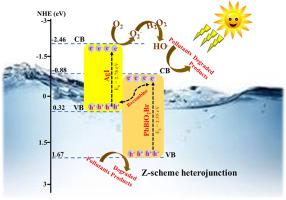Novel Z-scheme AgI@PbBiO2Br heterojunction for efficient photodegradation of organic pollutants and bacteria inactivation: DFT simulation, explore active radicals, and mechanism insight
IF 4.6
3区 工程技术
Q2 ENGINEERING, ELECTRICAL & ELECTRONIC
引用次数: 0
Abstract
In this study, novel Z-scheme AgI@PbBiO2Br heterojunctions were prepared using a simple in situ precipitation approach to effectively degrade organic pollutants and inactivate gram-negative Escherichia coli (E. coli) and gram-positive Staphylococcus aureus (S. aureus) bacteria when exposed to visible light. The prepared materials were comprehensively evaluated using several analytical procedures. The 20 %-AgI@PbBiO2Br presented the best photocatalytic performance of all the catalysts prepared. The rhodamine B (RhB) molecules were significantly reduced within 70 min (98.72 %), showing a much higher degradation efficiency than bare AgI (73.58 %) and PbBiO2Br (46.77 %) under the same conditions. The degradation of methyl orange (MO), neutral red (NR), and tetracycline (TC) by 20 %-AgI@PbBiO2Br was also examined, resulting in nearly total elimination of MO, NR, and TC pollutants, respectively. In addition, the antibacterial efficacy of 20 %-AgI@PbBiO2Br against E. coli and S. aureus reaches about 99.99 %. The improved photodegradation efficacy of AgI@PbBiO2Br is owing to the construction of a heterojunction between AgI and PbBiO2Br, which increases effective charge separation and visible light absorption, thus enabling the decomposition of pollutants. Cycling experiments confirmed the stability and reusability of the material, demonstrating exceptional photocatalytic durability. The photocatalytic mechanism was thoroughly examined by reactive species capture assays and ESR analysis, confirming that holes and superoxide radicals are crucial in the photodegradation system. Additionally, the density functional theory (DFT) simulations and liquid chromatography-mass spectrometry (LC-MS) helped to clarify the susceptible active sites and possible degradation pathways of RhB. Overall, this work underlines the considerable ability of AgI@PbBiO2Br heterojunctions to effectively remove persistent pollutants from wastewater.

新型Z-scheme AgI@PbBiO2Br异质结高效光降解有机污染物和细菌灭活:DFT模拟,探索活性自由基,并深入了解机制
在本研究中,采用简单的原位沉淀法制备了新型Z-scheme AgI@PbBiO2Br异质结,可有效降解有机污染物,并在暴露于可见光下灭活革兰氏阴性大肠杆菌(E. coli)和革兰氏阳性金黄色葡萄球菌(S. aureus)细菌。用几种分析方法对制备的材料进行了综合评价。20% -AgI@PbBiO2Br的光催化性能最好。rhodamine B (RhB)在70 min内被显著还原(98.72%),其降解效率远高于相同条件下的裸AgI(73.58%)和PbBiO2Br(46.77%)。对甲基橙(MO)、中性红(NR)和四环素(TC)的降解率为20% -AgI@PbBiO2Br也进行了研究,分别几乎完全消除了MO、NR和TC污染物。另外,20% -AgI@PbBiO2Br对大肠杆菌和金黄色葡萄球菌的抗菌效果达到99.99%左右。AgI@PbBiO2Br光降解效率的提高是由于在AgI和PbBiO2Br之间构建了异质结,增加了有效电荷分离和可见光吸收,从而能够分解污染物。循环实验证实了材料的稳定性和可重复使用性,表现出优异的光催化耐久性。通过反应态捕获法和ESR分析对光催化机理进行了深入研究,证实了空穴和超氧自由基在光降解系统中起着至关重要的作用。此外,密度泛函数理论(DFT)模拟和液相色谱-质谱分析(LC-MS)有助于阐明RhB的敏感活性位点和可能的降解途径。总的来说,这项工作强调了AgI@PbBiO2Br异质结有效去除废水中持久性污染物的相当大的能力。
本文章由计算机程序翻译,如有差异,请以英文原文为准。
求助全文
约1分钟内获得全文
求助全文
来源期刊

Materials Science in Semiconductor Processing
工程技术-材料科学:综合
CiteScore
8.00
自引率
4.90%
发文量
780
审稿时长
42 days
期刊介绍:
Materials Science in Semiconductor Processing provides a unique forum for the discussion of novel processing, applications and theoretical studies of functional materials and devices for (opto)electronics, sensors, detectors, biotechnology and green energy.
Each issue will aim to provide a snapshot of current insights, new achievements, breakthroughs and future trends in such diverse fields as microelectronics, energy conversion and storage, communications, biotechnology, (photo)catalysis, nano- and thin-film technology, hybrid and composite materials, chemical processing, vapor-phase deposition, device fabrication, and modelling, which are the backbone of advanced semiconductor processing and applications.
Coverage will include: advanced lithography for submicron devices; etching and related topics; ion implantation; damage evolution and related issues; plasma and thermal CVD; rapid thermal processing; advanced metallization and interconnect schemes; thin dielectric layers, oxidation; sol-gel processing; chemical bath and (electro)chemical deposition; compound semiconductor processing; new non-oxide materials and their applications; (macro)molecular and hybrid materials; molecular dynamics, ab-initio methods, Monte Carlo, etc.; new materials and processes for discrete and integrated circuits; magnetic materials and spintronics; heterostructures and quantum devices; engineering of the electrical and optical properties of semiconductors; crystal growth mechanisms; reliability, defect density, intrinsic impurities and defects.
 求助内容:
求助内容: 应助结果提醒方式:
应助结果提醒方式:


